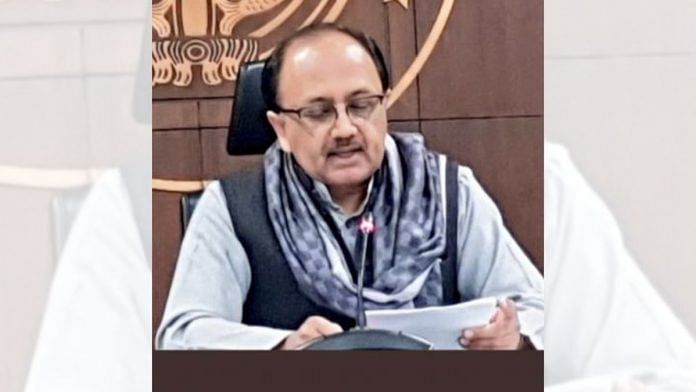Allahabad: Covid-19 has entered rural areas of the state and it’s a matter of “huge concern” for the state, said Sidharth Nath Singh, cabinet minister in the Uttar Pradesh government handling the MSME (Micro Small and Medium Enterprise) portfolio.
In a telephonic interview to ThePrint, the minister admitted the problem in rural areas gets compounded because of inadequate medical infrastructure.
Singh was previously the health minister of the state.
Asked if the multi-phased panchayat (local body) elections led to the surge in cases in rural areas, he said: “The matter (whether panchayat polls should be held) went upto the High Court, which allowed it.”
Singh said the number of health centres and MBBS doctors was inadequate in rural UP. “I remember when I took charge as health minister (in 2017), primary health centres (PHCs) were non-functional in the state. The number of MBBS doctors in government hospitals as against the total population is also inadequate. In UP, which has a population of over 20 crore, there are 18,000 sanctioned posts for doctors in government hospitals… the ratio does not match at any level.”
Sources in the UP government told ThePrint that while the sanctioned posts for doctors in government hospitals is 18,000, only a little over 13,000 doctors are actually working in the state.
Singh added this shortage is not because of Covid but has been there since before. “We are facing the heat now because of the pandemic,” he said.
With Covid numbers surging in rural areas, the minister said, the UP government is ramping up medical infrastructure in villages. “In villages, people hide their illness. They are reluctant to get themselves tested. We have roped in ASHA workers and about 3,000 women working with self help groups to go door to door and tell people to get themselves tested if they fall ill,” he said.
The cabinet minister said nobody is in denial that UP, like other states across India, was not prepared to handle the second wave of the Covid-19 pandemic. “It’s because after the first wave, we were expecting a storm but what came was a tsunami,” Singh said.
“Nobody anticipated it… such a tsunami will overwhelm any government. But you have to deal with it, stand with the public. There are problems but they need to be tackled. We are managing the situation, cases have started coming down in the last three days,” said Singh, who is also the UP government spokesperson.
UP registered 29,824 Covid-19 cases and 266 deaths Wednesday. Overall, UP is among the six most-affected states in India along with Maharashtra, Delhi, Tamil Nadu, Kerala and Karnataka.
On reports that there is discrepancy in the figures of Covid deaths that is given by the government and the numbers based on cremation and burial ground figures across districts, Singh categorically said that nobody is fudging figures.
“It’s a myth. No deaths are being hidden,” he said.
Also read: What caused rural Jaunpur’s Covid surge? UP govt suspects 1 lakh carriers
‘Number of existing hospital beds are saturated’
On the availability of hospital beds, Singh said there is a problem as the number of existing beds are saturated.
“But we are pushing up the number of beds. DRDO is erecting Covid hospitals… There is a push to increase the number of beds in every district.”
The minister said there are currently 1.16 lakh Covid isolation beds and 65,000 oxygen and ICU beds in the state. “Saturation (of beds) is happening because Covid patients are going to 4-5 hospitals in one area, which is overwhelming the resources.”
He added: “For instance, with the number of Covid positive cases going up in Lucknow, the beds have run out. But in nearby Gonda, beds are available.”
Singh said distribution of patients now needs to be managed as per the available beds in the districts. “Many people prefer going to a particular hospital. There are other patients, who are recovering and don’t need to be in hospital. If you start shifting them to basic isolation rooms available, then they create problems.”
As far as oxygen is concerned, Singh said UP is neck-and-neck in terms of demand and supply. “But we do require more and are arranging it.”
More RT-PCR testing machines and labs
UP is ramping up its testing facilities, Singh said.
“We have already placed orders for 40 RT-PCR machines. They will come by 10 May, which will push up testing figures,” said Singh.
He added that it’s not that the state had not done anything to ramp up health facilities.
For instance, he said, UP did not have a single lab in the state in 2020.
“We were sending our samples to Delhi and Pune. But in the last one year, we have added 130 government labs and between 115 and 120 laboratories in the private sector.”
Since coming to power in the state, Singh said, the government has also increased the number of medical colleges. “In 2017, there were just 12 medical colleges in UP. Now, 39 medical colleges have opened.”
(Edited by Sanghamitra Mazumdar)
Also read: Yogi’s Team-11 & how they are tackling Covid crisis in India’s now second worst-hit state






